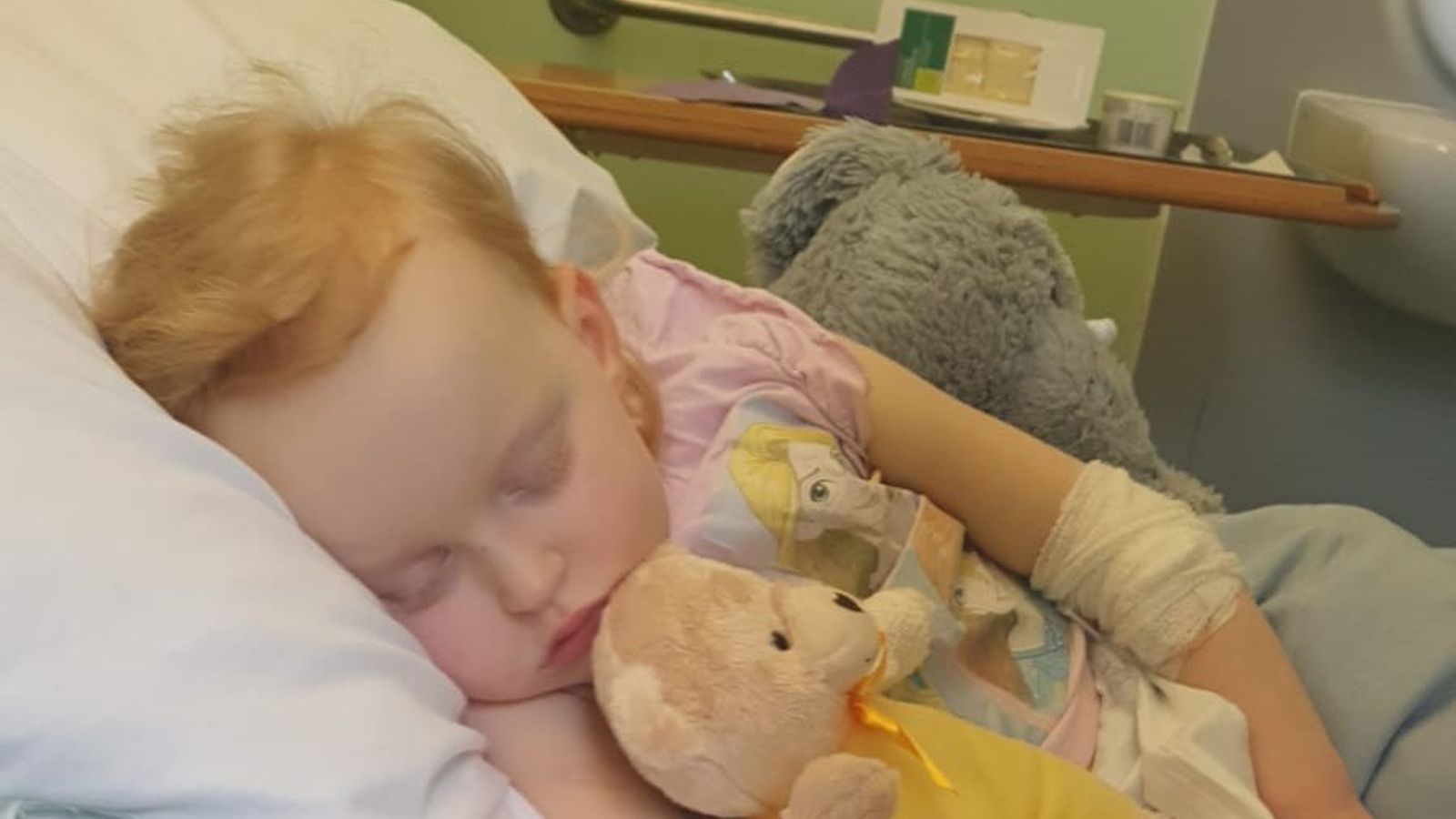Three-year-old Lola-Rose Raine suffered acute liver failure after falling ill with hepatitis.
She is one of 108 cases that have appeared in the UK since January.
Her father, Alan Raine, donated part of his liver to save his daughter’s life.
He has shared the story of what happened to Lola-Rose to alert parents to the early signs of contracting hepatitis.
March 13 – Lola’s eyes turn a strange colour
I came home at 1.40am and had settled into bed when I heard Lola coughing and trying to get out of bed. When I went into our hallway and looked into her bedroom, I saw Lola being sick on the bedroom carpet. I collected the bucket from the bathroom and rubbed her back until she had finished. I checked her temperature, which was normal, gave her a dose of Calpol for a tummy ache and tucked her back into bed. I laid on the floor bedside her bed until she fell asleep to make sure she was okay.
The next morning, while I was sleeping, Lola’s mum Jane got her and her sister up for breakfast and ready for the day.
When they came in to wake me, Lola was sitting on the edge of our bed facing the window. As she moved her eyes, Jane noticed a strange colour in the corner of them. It wasn’t easy to see. If Lola was looking straight at you, you couldn’t see it, but when she moved her eyes to the side while keeping her head still, you could see the colour change.
With us both being able to see this colour change in Lola’s eyes, we knew something was not right, so called NHS 111 for advice. After 45 minutes on the phone they told us to go to the urgent treatment centre at Gravesend Hospital.
Lola-Rose was thoroughly examined there, with Jane asked plenty of questions to gather background information. The out-of-hours GP said that he wanted Lola to be taken to A&E at Darent Valley straightaway.
He typed a letter and printed it for Jane to take with her. It mentioned jaundice, but reasons unknown, as Lola was an otherwise healthy child with no previous medical history.
At A&E they did more tests, checking vital signs as well as neurological observations. All her vitals were fine, but when the blood results came back they said that some of Lola’s were very abnormal and admitted her for further testing and observation.
Over the few days she spent there, doctors were liaising with King’s College Hospital in London on the best treatment for jaundice with no known causes. They started her on antibiotics and repeated her blood tests daily. During this time, her liver function tests were increasingly worse each time they tested her blood.
March 17 – Lola is transferred for specialist treatment in London
Having run out of ideas and tests they could do on Lola, doctors transferred her to King’s College Hospital, where she was admitted to the high dependency unit and closely monitored before being moved to a specialist paediatric liver ward called “Rays of Sunshine”.
They started running INR tests, which measure the time it takes for blood to clot. They told us this was a crucial job that the liver does. If this level was to reach four then she would need a liver transplant.
It very slowly increased over the time she was on Rays of Sunshine. She was behaving herself, laughing, playing, walking around so we were hopeful that her little body would fight this by itself and we would be on our way home before we knew it.
March 21 – Lola is suffering from acute liver failure
Lola’s bloods were checked daily on the specialist liver ward. That’s when they discovered a virus called adenovirus. It was treatable with a special medication made up specifically for Lola in the pharmacy and given to her through an IV drip.
We were then told that Lola was suffering from acute liver failure, secondary to adenovirus.
Three days later the nurse In charge organised a room for us in the Ronald McDonald House in Camberwell, so we could be closer to Lola. The house is literally a five-minute walk from the hospital and allowed us to get a proper night’s sleep and still be as close as possible.
March 25 – Lola is put into an induced coma
The day began with doctors telling us she was still deteriorating and warning Lola may be moved to intense care within 48 hours. After only four hours, our baby girl was transferred to the intensive care unit and put into an induced coma.
Her liver was now in complete failure and was affecting other parts in the body. One of the jobs of the liver to is pull toxins called ammonia out of your blood, sending it to your kidneys to become a waste product. But Lola’s liver was not doing this, so it was allowing these toxins to get to her brain, causing her brain to swell.
Lola was placed on a ventilator to breathe for her. She was given morphine and midazolam to put her to sleep. She was also given a medication to paralyse her, so she wouldn’t be moving while they were trying to attach all her lines. She had a feeding tube up her nose and a monitor attached to her forehead measuring the levels of oxygen in the brain.
A filter was attached to pull blood from her body, filter the ammonia out and send it back. But this meant that her blood was cold by the time it got back to her body, so she had to have a heated blanket over her constantly. She had a central line in her neck, a subclavian line in her right shoulder and an arterial line in her left wrist. These gave her various medications constantly and allowed them to take blood gases every 4 hours.
March 26 – Lola placed on urgent transplant list
At 7.15am Jane was told Lola was officially on the urgent transplant list. Now, all we could do was wait.
Jane knew that she was a blood match for Lola, being in the same blood group. So, we wanted to start something called the living donor process as soon as we could.
But she had to be on the urgent list for three days before we could start this process. We tried all weekend, and finally managed to start the process the morning of Tuesday 29. Starting this process did not remove Lola from the urgent transplant list. It ran alongside it. This process usually takes around six weeks to complete.
March 29 – Lola deteriorates to extremely dangerous level
Now, referring back to the INR levels we mentioned earlier – these levels were closely monitored every day. On the morning of March 28 they tested Lola’s levels and they were 5.3. That was worse than before, but to be expected.
A day later she was tested again. During the ward round they didn’t believe the result, so they tested them for a second time that same morning. The result was correct. Her INR level had jumped to nine.
This was deemed extremely dangerous and needed to be dealt with as soon as possible.
We contacted the department for living donor transplantation to say we both wanted to put ourselves forward for this operation to save our baby girl.
Jane was told she was not a suitable donor for Lola, even though we knew she was a blood match. I got an urgent appointment to have an ultrasound, ECG, chest X-ray, CT scan and for around 25 blood samples to be taken.
The second I walked out of the CT suite my phone rang to tell me I was a match. The bloods and other tests took around three hours to complete.
I made my way to the paediatric ICU for a meeting with the surgeon to talk through the risks of the procedure. They carried out a physical and mental assessment, and determined I was actually a relation to Lola and hadn’t been forced or bribed into being a donor.
Our surgery was scheduled for the next morning.
March 30 – The day I helped save my daughter’s life
I went into surgery at 8.30am. Lola followed at 10.30am. It took around six hours from me going into theatre to being moved to ICU for the night, and seven hours for Lola. The left lateral segment of my liver had been donated.
After her transplant Lola’s colour came back really quickly. Within 48 hours her blood results were almost back to normal, but she was still having blood tests and an ultrasound daily.
April 2 – Lola needs urgent surgery for a blood clot
On the third day, they noticed a change in her blood results. They brought Lola’s ultrasound forward and did it during the morning, when it was usually done in the afternoon. The nurse in charge called Jane and told her to come in from the house. They found a blood clot in the portal vein – a blood vessel that carries blood from the gastrointestinal tract, gallbladder, pancreas and spleen to the liver.
Lola was sent for a CT scan to have a closer look, and Jane was told she may need surgery. That’s exactly what they did. She went from CT straight to surgery for another 3 hours. The surgeon said that the clot wasn’t were they expected it, but that it had been cleared, and Lola was stable.
Despite that blip, Lola is recovering well.
She has been moved out of ICU and is back on the Rays of Sunshine ward, where she requires a lot of physio to regain her strength from being laid up in bed for so long.
April 22 – Lola is looking forward to going home
Lola is now coming along fantastic. Her physio is going really well and we’re all super pleased with the care and support we have received from everybody involved.
We expect her to be back home within the next couple of weeks safe and well.







